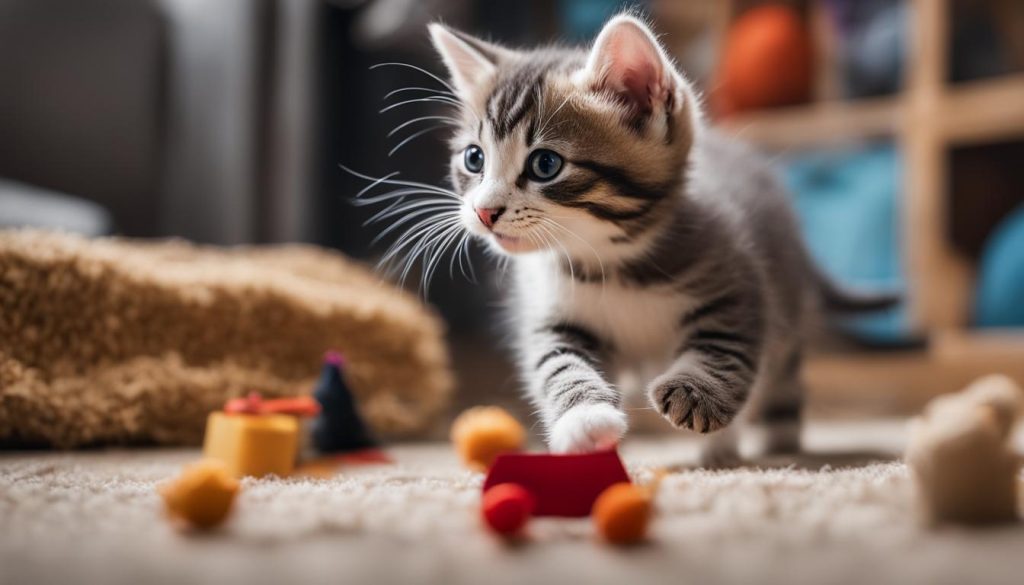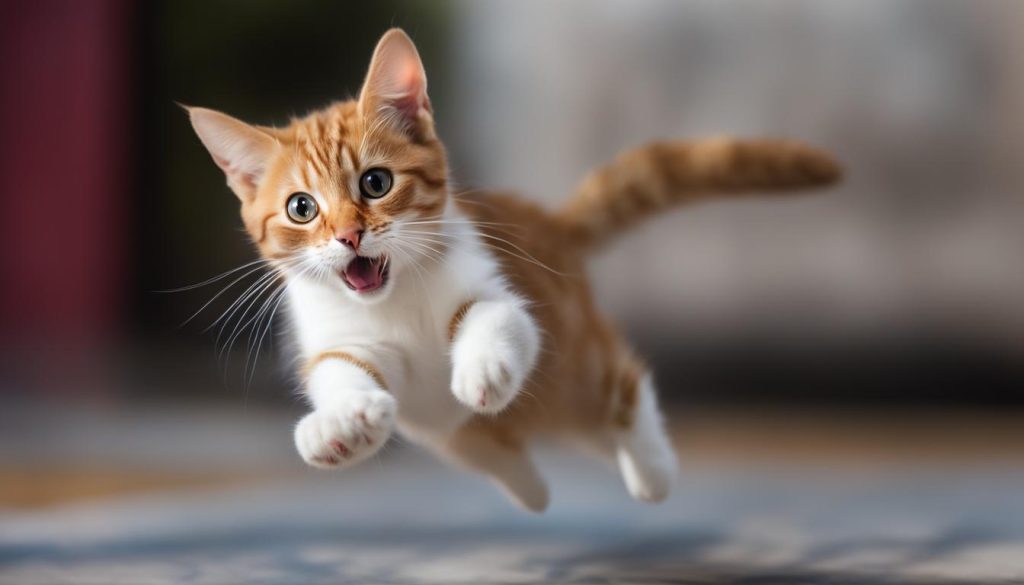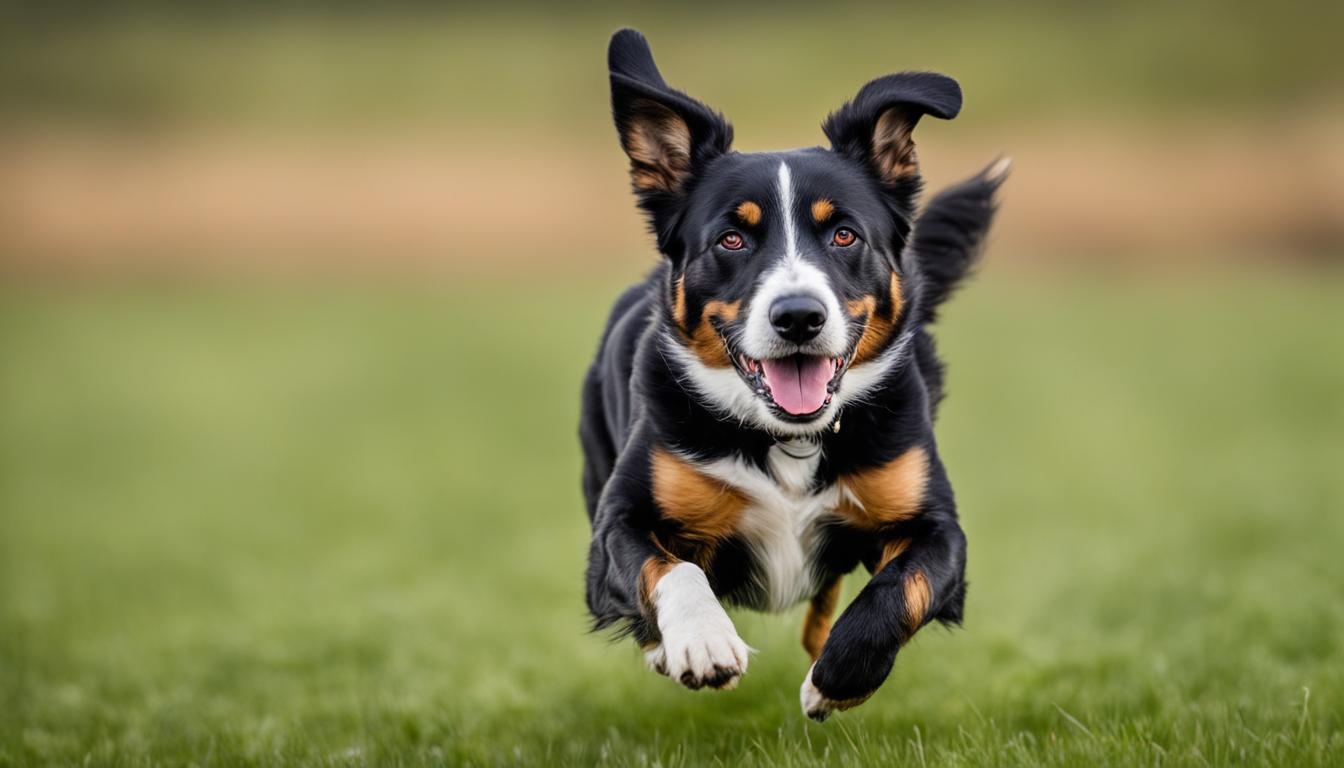Welcome to our comprehensive guide on capturing amazing action shots of your pets. Whether you’re a passionate pet owner or a professional photographer, these tips and tricks will help you elevate your pet photography skills and capture the unique moments that make your furry friends so special.
Capturing action shots of pets can be challenging, but with the right techniques and equipment, you can freeze those playful moments and preserve them forever in stunning photographs. From choosing the perfect lighting to selecting the right camera settings, we’ve got you covered.
Key Takeaways:
- Use natural lighting to enhance the mood and bring out the best in your pet’s features.
- Invest in quality equipment, including a camera with high-speed continuous shooting and good autofocusing capabilities.
- Focus on the pet’s eyes to create sharp and compelling portraits.
- Experiment with different techniques to capture your pet’s unique personality and energy in action shots.
- Have fun and enjoy the process of photographing pets in action.
Tips for Using Natural Lighting in Pet Photography
When it comes to pet photography, lighting plays a crucial role in capturing stunning images. Natural lighting can bring a unique charm and authenticity to your pet photos. In this section, we will explore the benefits of using natural lighting and provide valuable tips on how to make the most of it to enhance your pet photography skills.
The Benefits of Natural Lighting
Using natural lighting in pet photography can produce beautiful results. Here are some key benefits:
- Natural lighting creates a soft and delicate atmosphere that complements your pet’s natural beauty.
- It brings out the vibrant colors of your pet’s fur and eyes, enhancing the overall visual appeal of the image.
- Using natural light allows for more flexibility and spontaneity during your pet photography sessions.
- It adds a touch of warmth and a natural glow to your pet’s features, resulting in captivating and authentic portraits.
Tips for Utilizing Natural Lighting
To make the most of natural lighting in your pet photography, consider the following tips:
- Shoot during the Golden Hours: The Golden Hours, which are the first hour after sunrise and the last hour before sunset, provide the most flattering natural light. During these times, the sunlight is softer and creates a warm, golden glow.
- Paying attention to the sun’s angle: Position yourself and your pet in a way that utilizes the light from the sun. Experiment with different angles to achieve the desired effect and avoid unwanted shadows.
- Creating beautiful silhouettes: Use backlight to create dramatic silhouettes of your pet. Position your pet between the camera and a well-lit background for stunning results.
Optimal Settings for Pet Photography in Different Lighting Conditions
Adjusting your camera settings to match the lighting conditions is crucial for capturing the best possible pet photos. Here are some general guidelines:
| Lighting Condition | Recommended Settings |
|---|---|
| Bright sunlight | Use a low ISO (100-200) and a fast shutter speed to prevent overexposure. |
| Cloudy or overcast | Increase your ISO slightly (around 400-800) to compensate for the lower light level. |
| Indoor lighting | Use a higher ISO (800-1600) and consider using a wider aperture to allow enough light into the camera. |
By understanding the benefits of natural lighting, implementing the provided tips, and adjusting your camera settings accordingly, you can elevate your pet photography to the next level. Now, let’s move on to the next section, where we will explore how to choose the right equipment for capturing stunning pet photos.
Choosing the Right Equipment for Pet Photography
When it comes to pet photography, having the right equipment can make all the difference in capturing stunning images of your furry friends. In this section, we will guide you through the process of selecting the best pet photography equipment, from cameras to lenses and everything in between.
Camera Features for Pet Photography
When choosing a camera for pet photography, there are a few key features to consider that can enhance your shooting experience and improve the quality of your images. Look for a camera with:
- High-Speed Continuous Shooting Mode: This feature allows you to capture multiple frames per second, which is essential for capturing fast-moving pets in action.
- Good Autofocusing Capabilities: A camera with reliable autofocus will help you keep your pets in focus, even when they are on the move.
Recommended Lenses for Pet Photography
The right lens can significantly impact the outcome of your pet photos by allowing you to capture details and create beautiful compositions. Here are some lens recommendations:
- Kit Zoom Lenses: Kit zoom lenses, such as the Nikon AF-S DX NIKKOR 18-55mm f/3.5-5.6G VR II or the Canon EF-S 18-55mm f/3.5-5.6 IS STM, offer versatility and are a great starting point for pet photography.
- Telephoto Lenses: Telephoto lenses, like the Sony FE 70-200mm f/2.8 GM OSS or the Tamron SP 70-200mm f/2.8 Di VC USD G2, allow you to capture close-up shots of your pets from a distance, ideal for photographing skittish animals or wildlife.
- Prime Lenses: Prime lenses, such as the Canon EF 50mm f/1.8 STM or the Nikon AF-S FX NIKKOR 50mm f/1.8G, offer wide apertures that allow for beautiful bokeh and low-light shooting, perfect for capturing portraits of your pets.
Camera Modes and Settings for Pet Photography
Choosing the right camera mode and settings is crucial for capturing the personality of your pet. Here are a few modes and settings to consider:
- Manual Mode: Manual mode gives you full control over your camera settings, allowing you to adjust the aperture, shutter speed, and ISO to achieve the desired effect.
- Aperture Priority Mode: Aperture Priority mode is a semi-automatic mode that allows you to set the desired aperture while the camera selects the appropriate shutter speed. This mode is great for achieving a shallow depth of field or controlling the background blur.
Remember, the best equipment for pet photography may vary depending on your personal preferences and shooting style. It’s essential to experiment with different gear and settings to find what works best for you. Now that you have an understanding of the equipment and settings involved, you’re ready to capture incredible pet photos that will leave a lasting impression!
Tips for Capturing Sharp and Crisp Pet Portraits
When it comes to pet photography, capturing sharp and crisp pet portraits is essential to showcase their unique personalities. In this section, we will explore some valuable tips that will help you achieve sharp focus and stunning pet portraits every time.
1. Focus on the Pet’s Eyes
One of the key elements in capturing sharp pet portraits is to focus on the pet’s eyes. The eyes are the windows to their soul and can convey a lot of emotions. By focusing on their eyes, you can create a powerful and engaging image that draws viewers in.
To achieve this, utilize the eye autofocus feature available on many cameras. This setting automatically detects and focuses on the pet’s eyes, ensuring they are sharp even if they move during the shoot. Additionally, consider using the single-point AF area mode for precise focus on the eyes.
2. Deal with Shallow Depth of Field
Shallow depth of field can create a beautiful, blurred background that emphasizes the pet’s sharp features. However, it can also make it challenging to achieve sharp focus on the eyes. To overcome this, adjust your camera settings to increase the depth of field.
Use a smaller aperture (higher f-stop number) to increase the depth of field and extend the area in focus. This technique allows for more margin of error in focusing, ensuring that both the eyes and the surrounding areas remain sharp and detailed.
3. Utilize Natural Light
Natural light can enhance the sharpness and details in your pet portraits. Take advantage of soft, diffused natural light to ensure even illumination and minimize harsh shadows that might distract from the subject. Avoid direct sunlight, which can cause squinting or overexposure.
Position your pet near a large window or bring them outside during the golden hours of sunrise or sunset when the light is gentle and warm. This lighting will add a beautiful glow to your pet’s features and allow you to capture sharp, well-lit portraits.
4. Mentally Prepare and Maintain Patience
“Photography is the art of frozen time… the ability to store emotion and feelings within a frame.” – Meshack Otieno
Taking sharp and crisp pet portraits requires patience and a calm demeanor. Pets can be unpredictable, and it may take time to capture that perfect moment. Take a few moments before the shoot to mentally prepare yourself and create a calm environment to ensure your pet feels comfortable and relaxed.
Remember, great pet portraits are more than just technical perfection. They are a reflection of the love and connection you share with your furry friend. Take the time and be patient, allowing their true personality to shine through in the final image.

By following these tips and techniques, you will be well on your way to capturing sharp and crisp pet portraits that showcase the beauty and essence of your beloved pets. Remember to focus on the eyes, adjust depth of field, utilize natural light, and maintain patience throughout the process. The result will be stunning pet portraits that you can cherish for a lifetime.
Techniques for Photographing Pets in Action
When it comes to capturing those unforgettable pet action shots, it’s all about timing, technique, and a little bit of patience. Whether you’re photographing a playful pup or a nimble cat, these tips will help you freeze their motion and capture their lively personalities.
1. Use Fast Shutter Speeds: To freeze the motion of your pets, it’s essential to use a fast shutter speed. This will help you avoid any blur and capture sharp, crisp images. Start with a shutter speed of at least 1/500th of a second and adjust accordingly based on the speed of your pet’s movements.
2. Timing is Key: Anticipating your pet’s actions and timing your shots is crucial for capturing the perfect moment. Keep your camera ready and be patient. Look for those split-second expressions or movements that truly capture your pet’s energy and character.
3. Engage and Keep Their Attention: Pets can be easily distracted, so it’s important to keep their attention during the shoot. Use toys, treats, or sounds that your pet responds to. This will help you direct their actions and capture genuine expressions and movements.
“Photographing pets in action requires a mix of skill and instinct. Be prepared to experiment and adapt to their unpredictable behavior to get those fantastic shots.” – Sarah Thompson, Pet Photographer
Taking it to the Next Level: Photographing Pets in Their Natural Environment
While capturing action shots of pets in a studio setting can be fun, photographing them in their natural environment adds an extra layer of authenticity. Whether it’s at a park, beach, or even at home, shooting in a familiar surrounding allows your pet to be themselves and helps you capture their true personality.
Here are a few tips for photographing pets in their natural environment:
- Choose the Right Location: Select a location that reflects your pet’s personality and suits their activity level. A park with open spaces, a beach with waves, or a cozy corner in your home can all make for great backdrops.
- Be Patient and Observant: Allow your pet to explore and be themselves. Patience is key as you wait for those moments of playfulness or curiosity that make for captivating photos.
- Focus on Details: Pay attention to the small details that make your pet unique. Capture their expressive eyes, their wagging tail, or their paws in action. These details add depth and character to your images.
Remember, when photographing pets in action, it’s important to have fun and let their vibrant personalities shine through. Use these techniques and tips to create pet action shots that truly capture the joy and energy of your furry friends.

| Tip | Description |
|---|---|
| Use Fast Shutter Speeds | Setting your camera to a fast shutter speed will help freeze the motion and avoid blur in your pet action shots. |
| Timing is Key | Anticipate your pet’s actions and be ready to capture the perfect moment that showcases their energy and character. |
| Engage and Keep Their Attention | Use toys, treats, or sounds to direct your pet’s actions and keep their attention focused on the camera. |
| Photographing Pets in Their Natural Environment | Shooting in a familiar location allows your pet to be themselves and adds authenticity to your images. |
| Choose the Right Location | Select a location that reflects your pet’s personality and provides opportunities for them to engage in their favorite activities. |
| Be Patient and Observant | Allow your pet to explore and capture those moments of playfulness or curiosity that make for dynamic photos. |
| Focus on Details | Zoom in on the little things that make your pet unique, such as their expressive eyes or their paws in motion. |
Conclusion
In conclusion, capturing amazing photos of pets in action requires a combination of technical skills, patience, and creativity. By following the tips and tricks outlined in this article, you will be well-equipped to take stunning pet photos that truly capture the essence of your furry friends. Remember to experiment, have fun, and most importantly, enjoy the process of photographing pets in action.
Throughout this guide, we’ve delved into the importance of lighting, equipment selection, focusing techniques, and action photography tips to help you elevate your pet photography skills. Whether you’re a beginner or a seasoned photographer, these insights will enable you to create captivating images of your four-legged companions.
As you embark on your pet photography journey, don’t be afraid to think outside the box and try new techniques. Every pet has its own unique personality, so capturing their individuality can make for truly remarkable photographs. Remember to be patient and allow for spontaneity during your shoots, as some of the most memorable shots often come from unexpected moments.
So grab your camera, find the perfect lighting, and let your creativity soar as you embark on a pet photography adventure. With these tips and tricks, along with your love for animals, you’ll be able to capture stunning action shots that will truly showcase the special bond between pets and their owners.
FAQ
What are some tips for capturing action shots of pets?
To capture action shots of pets, it’s important to use fast shutter speeds to freeze motion. Timing is key, so be prepared to press the shutter at the perfect moment. Keeping your pet’s attention during the shoot can also help you capture more dynamic photos.
How can I make the most of natural lighting in pet photography?
Natural lighting can make your pet photos look more vibrant and natural. Shoot during the golden hour, which is the hour after sunrise or before sunset, when the light is soft and warm. Pay attention to the sun’s angle and use backlighting to create beautiful silhouettes. Experiment with different lighting conditions to capture the best shots.
What equipment do I need for pet photography?
For pet photography, you’ll need a camera with a high-speed continuous shooting mode and good autofocusing capabilities. Invest in a versatile lens that allows you to zoom in and out. Kit zoom lenses, telephoto lenses, and prime lenses are all great options. Use manual mode or aperture priority mode to have more control over your settings.
How can I ensure my pet portraits are sharp and crisp?
Focusing on the pet’s eyes is crucial for sharp portraits. Use tools like eye autofocus and single-point AF area mode to ensure your pet’s eyes are in sharp focus. Be mindful of shallow depth of field and consider increasing the depth of field for more margin of error in focusing.
What are some techniques for capturing pets in action?
To capture pets in action, use fast shutter speeds to freeze their movement. Experiment with different shutter speeds to best capture the action. Take advantage of your pet’s natural environment to capture their character and personality. Patience and timing are key to capturing the perfect action moment.






